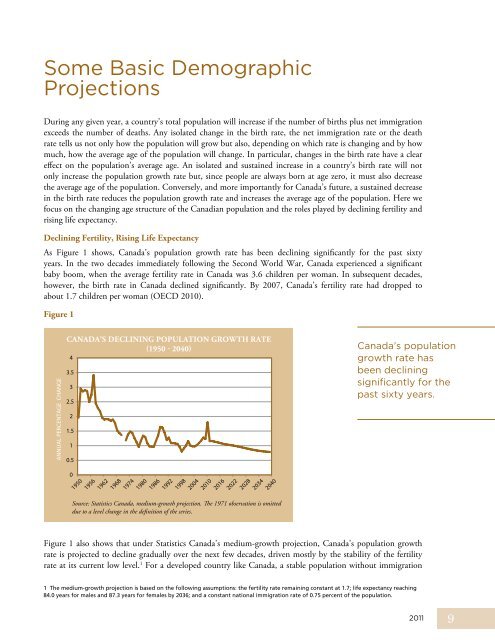Christopher Ragan, "Canada's Looming Fiscal Squeeze," November
Christopher Ragan, "Canada's Looming Fiscal Squeeze," November
Christopher Ragan, "Canada's Looming Fiscal Squeeze," November
You also want an ePaper? Increase the reach of your titles
YUMPU automatically turns print PDFs into web optimized ePapers that Google loves.
Some Basic Demographic<br />
Projections<br />
During any given year, a country’s total population will increase if the number of births plus net immigration<br />
exceeds the number of deaths. Any isolated change in the birth rate, the net immigration rate or the death<br />
rate tells us not only how the population will grow but also, depending on which rate is changing and by how<br />
much, how the average age of the population will change. In particular, changes in the birth rate have a clear<br />
effect on the population’s average age. An isolated and sustained increase in a country’s birth rate will not<br />
only increase the population growth rate but, since people are always born at age zero, it must also decrease<br />
the average age of the population. Conversely, and more importantly for Canada’s future, a sustained decrease<br />
in the birth rate reduces the population growth rate and increases the average age of the population. Here we<br />
focus on the changing age structure of the Canadian population and the roles played by declining fertility and<br />
rising life expectancy.<br />
Declining Fertility, Rising Life Expectancy<br />
As Figure 1 shows, Canada’s population growth rate has been declining significantly for the past sixty<br />
years. In the two decades immediately following the Second World War, Canada experienced a significant<br />
Canada’s baby declining boom, population when growth the average rate. 1950 - 2040 fertility rate in Canada was 3.6 children per woman. In subsequent decades,<br />
however, the birth rate in Canada declined significantly. by 2007, Canada’s fertility rate had dropped to<br />
about 1.7 children per woman (oeCD 2010).<br />
Figure 1<br />
ANNUAL PERCENTAGE CHANGE<br />
CANADA’S DECLINING PoPuLATIoN GRoWTH RATE<br />
(1950 - 2040)<br />
4<br />
3.5<br />
3<br />
2.5<br />
2<br />
1.5<br />
1<br />
0.5<br />
0<br />
1950<br />
1956<br />
1962<br />
1968<br />
1974<br />
1980<br />
1986<br />
1992<br />
1998<br />
2004<br />
2010<br />
2016<br />
2022<br />
2028<br />
2034<br />
2040<br />
Source: Statistics Canada, medium-growth projection. The 1971 observation is omitted<br />
due to a level change in the definition of the series.<br />
Canada’s population<br />
growth rate has<br />
been declining<br />
significantly for the<br />
past sixty years.<br />
Figure 1 also shows that under Statistics Canada’s medium-growth projection, Canada’s population growth<br />
rate is projected to decline gradually over the next few decades, driven mostly by the stability of the fertility<br />
rate at its current low level. 1 For a developed country like Canada, a stable population without immigration<br />
1 The medium-growth projection is based on the following assumptions: the fertility rate remaining constant at 1.7; life expectancy reaching<br />
84.0 years for males and 87.3 years for females by 2036; and a constant national immigration rate of 0.75 percent of the population.<br />
2011<br />
9





